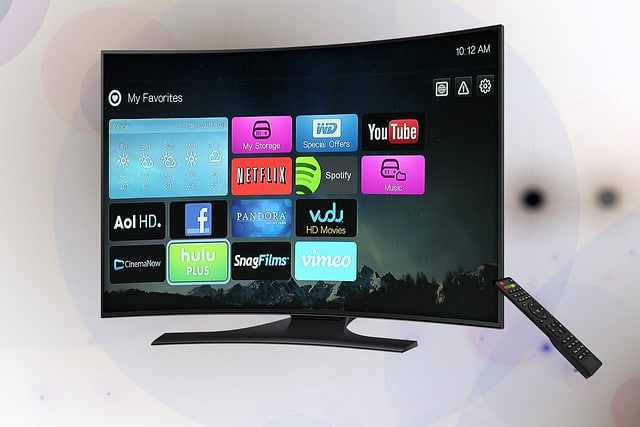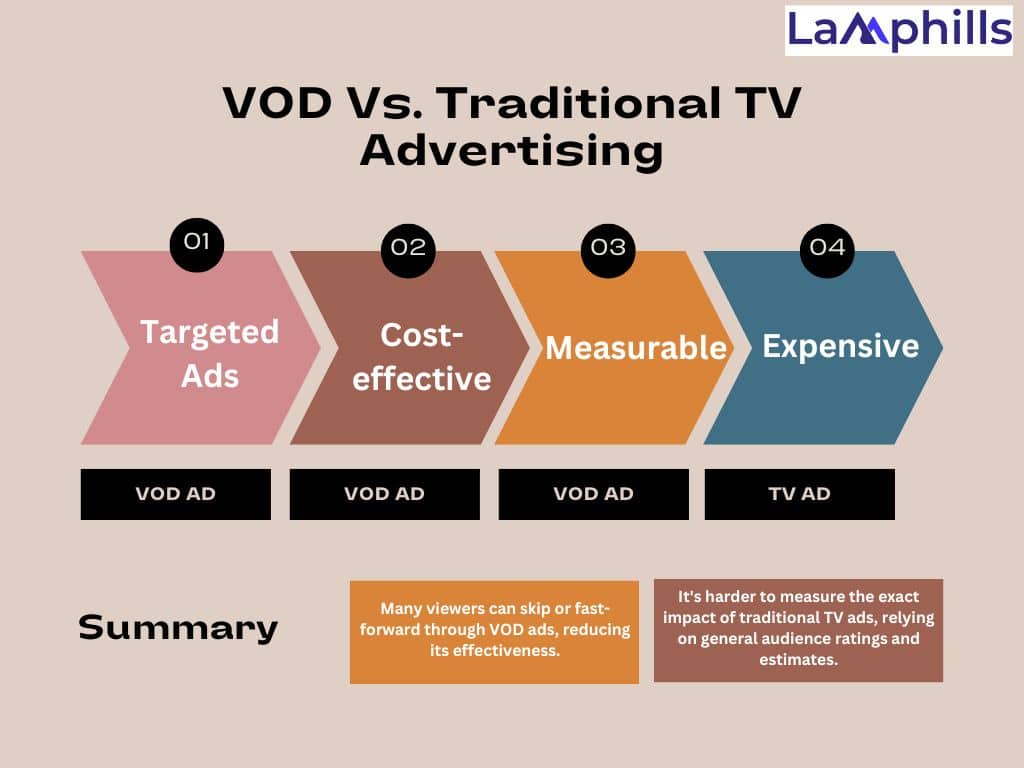If you want to find out which is better for your business between VOD Advertising and Traditional TV Advertising, you’re reading the right article. Advertising has changed a lot over the years. With the rise of the internet and new technology, we now have more ways to reach people than ever before.
I remember when my family would gather around our old, bulky TV every evening, excited to watch our favorite shows and the commercials that came with them. Traditional TV ads were big back then, with companies fighting for the best spots. Today, things have changed a lot. As someone who has worked in digital marketing for over 4 years, I’ve seen the big shift from traditional TV ads to video-on-demand (VOD) ads. This change has affected how we watch shows and create advertising strategies.
These two advertising methods have pros and cons. VOD Advertising lets viewers watch content whenever they want, often without commercials. On the other hand, Traditional TV Advertising reaches a wide audience at specific times. Let’s explore their differences further, including their pros and cons, to help you decide which might be the best fit for your advertising needs.
Understanding the Terms
Traditional TV Advertising
Traditional TV advertising, also known as linear TV advertising, involves creating short commercials shown on television during breaks in regular programming. These commercials are designed to promote products, services, or brands. Companies pay TV networks to air their ads at specific times when they believe their target audience is most likely to be watching. The goal is to reach many viewers and persuade them to buy the advertised products or services.
This TV advertising shows viewers ads based on the channel, show, and time. This means your ads may reach some of your target audience, but they will likely also reach many people who are not in your target audience.
VOD advertising
VOD advertising, or Video On Demand advertising, is a type of digital marketing where ads are shown to viewers who watch TV shows or movies online whenever they want. Instead of watching TV at a specific time, people can choose what they want to watch and when, and advertisers place their ads within these videos. This way, ads reach viewers who are watching their favorite shows or movies on platforms like Netflix, Hulu, or YouTube.
How it works
Video on Demand (VOD) advertising works by showing ads to viewers when they watch shows or movies online at any time they choose. Unlike traditional TV ads, VOD ads can target specific audiences based on their interests, viewing habits, and other personal data. This means the ads are more likely to be seen by people who are interested in the products or services being advertised.
VOD Advertising vs. Traditional TV Advertising- Which is Better?
For many years, traditional TV ads were a mainstay in marketing. They reached a wide audience and were great for brands wanting to get noticed. However, as technology improved and people’s viewing habits changed, the drawbacks of traditional TV ads became clear. VOD ads became a more flexible and targeted option, perfect for today’s viewers who prefer watching on demand.
Here’s a chart comparing VOD vs. Traditional TV Ads. This chart helps you see the differences between them. It compares how each one works, how much they cost, how they reach people, and more. This way, you can decide which type of advertising is best for your needs.
#1. Accessibility and Availability
In VOD advertising, you can access these ads anytime because you can choose when to watch the shows or movies. As long as you have an internet connection and a device like a smartphone, tablet, smart TV, or computer, you can see VOD ads whenever you want.
Traditional TV advertising it’s different. To access these ads, you need a TV and a subscription to a cable or satellite service. The availability of these ads depends on the TV schedule, meaning you can only see them when the shows or events are broadcast at specific times set by the TV networks. If you miss the show, you miss the ads unless you recorded it.
In simple terms, VOD advertising is more flexible and always available as long as you have internet and a device, while traditional TV advertising requires you to follow the TV schedule and have a cable or satellite subscription.
#2. Quality of Content
In VOD advertising, the quality of content is usually high because it is often shown alongside popular, on-demand shows and movies on streaming platforms like Netflix, Hulu, or Disney+. These platforms invest a lot in producing or acquiring top-quality content that viewers choose to watch. Since viewers can pick what they want to see and when they want to see it, they are more likely to engage with the content and, therefore, the ads that come with it. This means the ads are often targeted and more relevant to the viewers’ interests.
Traditional TV advertising, on the other hand, appears during live TV broadcasts. The quality of the content can vary widely depending on the show or event being aired. TV networks also produce high-quality shows, but viewers have less control over what is on at any given time. They might watch because it’s on then, not necessarily because they chose it. As a result, ads might not be as targeted or relevant to the specific interests of the viewers.
In addition, VOD advertising benefits from being paired with high-quality, viewer-selected content, leading to more relevant ads. Traditional TV advertising relies on the scheduled content, which can vary in quality and may not always match the viewers’ preferences as closely.
#3. Reach and Targeting Capabilities

VOD advertising is found in content you watch on streaming platforms like Netflix, Hulu, or Disney+. The reach of VOD advertising depends on how many people use these platforms. Since many people use these services worldwide, VOD advertising can potentially reach a large and diverse audience. However, its true strength lies in targeting. Streaming platforms collect data on what viewers like to watch, as well as their age, location, and interests. This data allows advertisers to show ads to specific groups of people who are more likely to be interested in their products. For example, a company selling running shoes can show their ads to people who often watch fitness videos.
Traditional TV advertising, on the other hand, appears during live TV broadcasts on cable or satellite. The reach of traditional TV advertising can be very wide, especially if the ad is shown during popular shows or big events like the Super Bowl. Many people might see the ad at the same time. However, targeting is less precise.
While advertisers can choose to place their ads during shows that generally attract certain types of viewers, they cannot be as specific as VOD platforms. For instance, they might place a toy commercial during a children’s show, hoping most viewers will be kids, but they can’t target a specific age group or interest as accurately.
#4. Cost-Effectiveness
Cost is another important factor when comparing VOD and traditional TV ads. Traditional TV ads can be very expensive, especially for prime-time spots. The high production and airtime costs can be tough for small businesses or startups.
VOD ads, however, are more budget-friendly. With different pricing models like pay-per-click or pay-per-view, advertisers can control their spending and only pay for actual engagement. In a campaign for a local event, we used a small budget for VOD ads and saw great returns. Being able to manage costs while targeting a specific audience made VOD ads a smart choice for us.
#5. Measurement and Analytics
In today’s world, data is crucial. One of the best things about VOD ads is the ability to measure and analyze their performance in real time. Traditional TV ads give limited insights, often relying on estimates.
VOD platforms, on the other hand, offer detailed analytics tools that let advertisers track views, engagement, and conversions. In a recent project for a fashion brand, we used VOD ads on YouTube to promote a new clothing line. The detailed analytics helped us adjust our strategy quickly, optimizing ad placements and messaging for the best results. This kind of insight and flexibility is invaluable in today’s fast-paced advertising world.
#6. Viewer Engagement and Experience

Image by Victoria from Pixabay
Viewer engagement is also key. Traditional TV ads can feel like annoying interruptions, leading to “ad fatigue.” Viewers might tune out or skip ads altogether, making them less effective.
VOD ads, however, provide a smoother and more integrated experience. Platforms like Netflix and Hulu often show ads that match viewers’ interests, making them less annoying. Interactive features, like clickable links or call-to-action buttons, also boost engagement and drive conversions. I remember a campaign for a tech company where we used interactive VOD ads to show product demos. The engagement rates were much higher than traditional TV ads, showing how effective VOD can be in creating meaningful interactions with viewers.
#7. Ad Length and Format
VOD ads are flexible in length, ranging from a few seconds to several minutes, and can include interactive elements like clickable links. They offer varied formats, such as traditional commercials, sponsored content, and native ads, tailored to the on-demand viewing experience.
Traditional TV ads are non-interactive and have standardized lengths, typically 15, 30, or 60 seconds. They follow a set structure to fit scheduled programming and aim for broad appeal during commercial breaks in popular shows or events.
#8. Convenience
Video-on-demand (VOD) advertising is easy and straightforward. People can buy and watch as many videos as they like without confusion. VOD offers a user-friendly experience, allowing viewers to stream videos from anywhere, anytime.
#9. Connectivity
To watch VOD ads, all you need is a high-speed internet connection and a device. This reduces connectivity issues compared to traditional TV ads. Unlike TV ads, you can watch VOD ads anytime and anywhere with a good internet connection.
#10. Variety
VOD is popular because it offers many TV shows and movies. Users can access a large selection of content, including movies, news, and sports, from different countries anytime they want.
#11. Devices
VOD can be accessed on various devices, making it convenient to watch videos anywhere. You can stream VOD on HD TVs, computers, tablets, and smartphones, allowing you to watch your favorite content whenever and wherever you like.
#12. More screens
In the past, reaching people through ads was challenging and mostly limited to TV. With VOD advertising, you can reach a wider audience using multiple devices, such as smartphones, tablets, and smart TVs. This makes it easier and cheaper to reach a large audience.
#13. Easier sales conversion
Online video advertising allows for quick sales conversions. Unlike TV ads, where viewers must call for more information, VOD ads can include links that direct viewers to a website for more details or direct purchases. This makes it easier for viewers to buy products directly from their devices.
VOD Advertising vs. Traditional TV Advertising- Pros and Cons

Before a business can choose between advertising its products on VOD (Video on Demand) and traditional TV, it must understand that each method has advantages and disadvantages. This can help them choose the best option for reaching their audience and achieving their advertising goals.
Pros of VOD Advertising
1. Targeted Ads: VOD advertising lets businesses show ads to specific groups of people based on their interests and viewing habits.
2. Cost-effective: It can be cheaper because businesses pay based on views or clicks, making it easier to manage costs.
3. Flexible: Ads can be easily updated or changed whenever needed.
4. Measurable: Businesses can see detailed results, such as how many people watched the ad and for how long.
Cons:
1. Skippable: Many viewers can skip or fast-forward through VOD ads, reducing its effectiveness.
2. Limited Reach: VOD ads may not reach as large an audience as traditional TV ads during major broadcasts.
3. Ad Blockers: Some viewers use ad blockers, which can prevent ads from being seen.
Pros of Traditional TV Advertising:
1. Wide Reach: Traditional TV ads can reach a large audience at once, especially during popular shows or events.
2. Established Medium: TV advertising has been around for a long time and is well-trusted.
3. Captive Audience: Viewers are more likely to watch TV ads during commercial breaks.
Cons:
1. Expensive: Traditional TV ads can be costly, especially for prime-time slots.
2. Less Targeted: Targeting specific groups is harder, meaning many viewers might not be interested in the product.
3. Less Flexibility: Ads take longer to produce and schedule, making it harder to make quick changes.
4. Measurement: It’s harder to measure the exact impact of traditional TV ads, relying on general audience ratings and estimates.
In summary, VOD and traditional TV advertising offer unique benefits and challenges. VOD advertising is cost-effective for targeting specific audiences, but viewers may skip or block it. Traditional TV advertising can reach a wide and well-established audience, but it is often more expensive and less flexible. By weighing these pros and cons, businesses can choose the advertising method that best fits their needs.
Conclusion
Choosing between VOD and traditional TV ads depends on your brand’s goals, budget, and target audience. VOD ads are a great choice for businesses wanting to reach a specific group with precision and flexibility. However, traditional TV ads still work well for those seeking broad exposure and brand recognition.
In my experience, using both ads often gives the best results. By combining the strengths of VOD and traditional TV ads, brands can create a strategy that maximizes reach and engagement. As the advertising world keeps changing, staying flexible and open to new ideas will be crucial for success in this dynamic industry.
FAQs.
Is Traditional TV Advertising Still Effective?
It depends on what you want to achieve. If you’re running a local campaign, targeting older people, or aiming for a wide audience, traditional TV can still work well. However, Connected TV (CTV) is becoming more popular for a few reasons: it allows precise targeting, costs less, provides quick responses, and offers better tracking. This is why many advertisers now spend their money on CTV instead.
What is the Difference Between Traditional and Digital Advertising?
Traditional and digital advertising use different methods to reach customers and offer different benefits. Traditional advertising includes TV, radio, magazines, billboards, and ads on buses. These methods are good for local campaigns but have slower and lower conversion rates.
Digital advertising uses websites, apps, social media, and connected TVs. It can target specific audiences using data, making it generally cheaper and able to reach people worldwide. Digital ads allow two-way interaction with customers and provide quick, cost-effective results. However, digital advertising may not reach older audiences as effectively.
What Type of Media is Best for Advertising?
Print Advertising—Print media, such as newspapers and magazines, is still popular with advertisers. The physical act of turning pages captures readers’ attention and allows them to present detailed information.
Is TV Advertising Better than Online Advertising?
TV commercials have been a key part of advertising for many years, and they are known for reaching many people and creating emotional bonds with viewers. Online video ads, however, offer targeted marketing and the chance to engage people on social media platforms.
What are the advantages of VOD advertising?
What are the Benefits of VOD Advertising?
Benefits of Video on Demand (VOD) Advertising over Traditional TV Advertising:
- Convenience: Easy to access anytime.
- Connectivity: Available through the internet.
- Cost: Often cheaper than TV ads.
- Variety: More options for content.
- Devices: Can be watched on various devices.
- Affordability: More budget-friendly.
- Screen Time: More viewing opportunities.
- Sales Conversion: It is easier to turn viewers into customers.
Similar Articles
MARKETING VS ADVERTISING: Differences
What is Brand Advertising? How To Build Brand Awareness
PR vs. Advertising: Which One Will Skyrocket Your Brand?
Threads Advertising 101: A Complete Guide to Boost Your Campaigns






